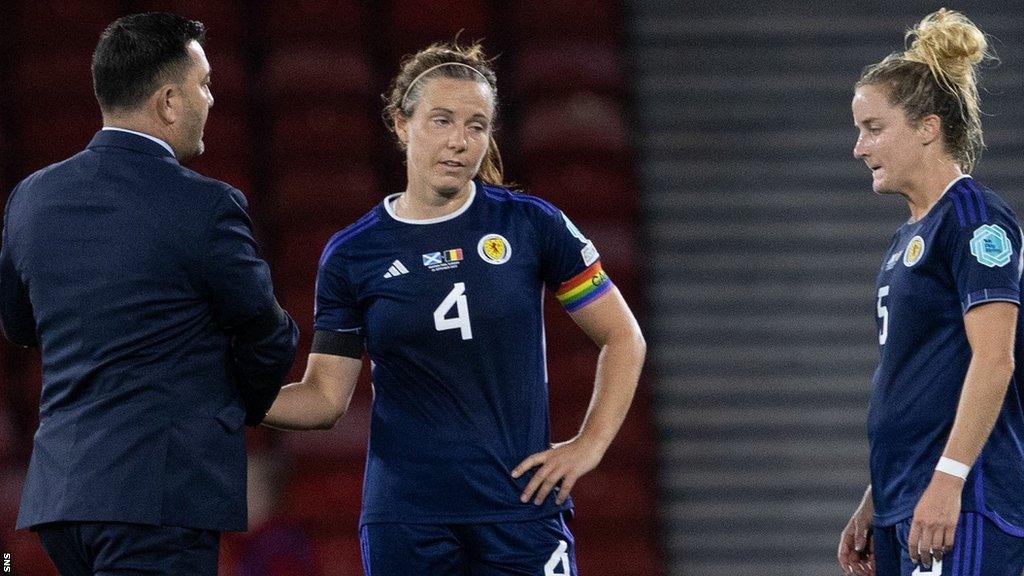Women's Euro 2025: Who might Scotland face in qualifying for finals in Switzerland?
- Published

Pedro Martinez Losa's side were relegated from Nations League A last time out
Scotland will learn the first stage of a potentially convoluted route to the Women's Euro 2025 finals when the qualifying draw is held at 12:00 GMT on Tuesday in Nyon.
Pedro Martinez Losa's side will be in League B as a new qualifying format is adopted to mirror the Nations League, from which his side were relegated from the top flight last time out.
Of Uefa's 55 countries, 51 will enter the draw, including Switzerland, who have automatically qualified for next year's tournament as the host nation despite also playing the qualifiers.
Qualifying takes place between April and July, with Scotland aiming to be among 15 other teams earning a place at the finals.
Here, BBC Scotland explains the draw and looks at who they could face.
How does the draw work?
The 51 teams have been split into three leagues - A, B and C.
Which teams enter which league was determined by the results of the 2023-24 Nations League campaign. Leagues A and B consist of 16 teams, while League C has 19 teams.
In each league, the teams have been split up into four seeding pots.
In Leagues A and B, four groups will be drawn consisting of a team from each pot, while League C has five groups.
The top two sides from each League A group will automatically qualify for Euro 2025. Scotland will be chasing one of the remaining seven spots decided via play-offs involving the best-ranked sides not to automatically qualify.
For the qualifiers, taking place between April and July, each team will play six games, facing the other teams in their group home and away.
Which pot are teams in and who could Scotland face?
Scotland make up one of four teams in the "relegated from League A" section of League B, which means they cannot be drawn against Portugal, hosts Switzerland or Wales.
Of those who they could face, Ukraine are the closest to Scotland's current ranking, being eight places behind in 33rd.
Martinez Losa's side could also face Serbia (36), Hungary (41), Northern Ireland (46), Slovakia (49), Croatia (58), Turkey (63), Bosnia and Herzegovina (64), Israel (69), Azerbaijan (76), Malta (86) and Kosovo (100).
Ukraine and Hungary were both in Scotland's last World Cup qualifying group, with the Scots winning three of those matches and drawing with Ukraine at Hampden.
League A
Pot 1: Spain, France, Germany, Netherlands
Pot 2: England, Denmark, Italy, Austria
Pot 3: Iceland, Belgium, Sweden, Norway
Pot 4: Republic of Ireland, Finland, Poland, Czech Republic
League B
Pot 1: Portugal, Switzerland, Scotland, Wales
Pot 2: Bosnia and Herzegovina, Serbia, Croatia, Hungary
Pot 3: Slovakia, Northern Ireland, Ukraine, Turkey
Pot 4: Malta, Israel, Kosovo, Azerbaijan
League C
Pot 1: Slovakia, Greece, Belarus, Romania, Albania
Pot 2: Latvia, Montenegro, Bulgaria, Estonia, Lithuania
Pot 3: Luxembourg, Kazakhstan, North Macedonia, Cyprus, Andorra
Pot 4: Georgia, Moldova, Faroe Islands, Armenia
How do the play-offs work?
After the group winners and runners up from each League A group have qualified, the remaining seven places will be taken by the best-ranked sides from all three leagues.
All third and fourth-placed teams from League A will qualify for the play-offs.
Scotland will aim to be among the top three teams in each League B group also making the play-offs. If Switzerland finish in the top three of their group, then the best ranked fourth-place team from League B will qualify for the play-offs.
From League C, the five group winners and three best-ranked runners-up will reach the play-offs.
The 28 teams making the play-offs will be whittled down to seven, with the first round being split into two groups.
The eight sides from League A will be drawn against the eight sides from League C. The six best teams from League B will face the six worst teams from League B. Both sets of matches are two-legged.
In the second play-off round, the 14 teams will be split in seedings. The top seven ranked winners will be drawn against the other seven winners - and the winners of those fixtures will take up the final seven play-off spots.